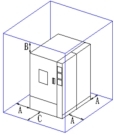
A humidity chamber, also known as a climatic chamber or environmental chamber, is a controlled environment used for testing the effect of various levels of humidity and temperature on products, materials, and electronics. These chambers are designed to simulate a range of environmental conditions and are used for a variety of purposes, including quality control, research and development, and stress testing.
Model: THS-800
Capacity: 800L
Shelf: 2 pcs
Color: Blue
Interior dimension:1000×800×1000 mm
Exterior dimension: 1560×1410×2240 mm
Humidity test chamber typically consists of an insulated cabinet equipped with temperature and humidity control systems, as well as sensors to monitor and maintain the desired conditions. The test specimen is placed inside the chamber and exposed to the specified temperature and humidity conditions.
Humidity chambers are commonly used in industries such as electronics, pharmaceuticals, medical devices, and automotive manufacturing. They play a crucial role in ensuring that products are able to withstand the effects of harsh environmental conditions and meet the necessary quality and reliability standards. You can click below video to learn details:
Specification
|
Model |
THS-50 |
THS-100 |
THS-150 |
THS-250 |
THS-500 |
THS-800 |
THS-1000 |
|
Interior Dimension |
350×320×450 |
500×400×500 |
500×500×600 |
600×500×810 |
800×700×900 |
1000×800×1000 |
1000×1000×1000 |
|
Exterior Dimension |
950×950×1400 |
1050×1030×1750 |
1050×1100×1850 |
1120×1100×2010 |
1350×1300×2200 |
1560×1410×2240 |
1560×1610×2240 |
|
Temperature Range |
0°C~+100°C |
||||||
|
Temperature Fluctuation: ≤±0.5°C; Temperature Uniformity: ≤2°C |
|||||||
|
Heating Rate |
2.0~3.0°C/min |
||||||
|
Cooling Rate |
0.7~1.0°C/min |
||||||
|
Humidity Range |
30% ~ 98% R.H (5%RH,10%RH also available) |
||||||
|
Humidity Bias |
+2/-3% R.H |
||||||
|
Interior Material |
SUS#304 brushed stainless steel |
||||||
|
Exterior Material |
Cold rolled steel plate with electrostatic spraying |
||||||
|
Insulation |
Superfine fiberglass wool / polyurethane foam |
||||||
|
Controller |
7” Programmable LCD touch screen controller |
||||||
|
Circulation System |
High temperature resistant motors, single cycle, long axis and stainless steel multi-leaf type centrifuge fan |
||||||
|
Humidification |
Shallow groove humidification, steam humidification mode, automatic water supply with water shortage alarm |
||||||
|
Dehumidification |
Refrigeration dehumidification mode |
||||||
|
Heating System |
NiCr heater, independent system |
||||||
|
Refrigeration |
France "TECUMSEH" Hermetic Compressors, Unit cooling mode/Dual cooling mode (air-cooling) |
||||||
|
Protection Devices |
Leakage and outage protection, compressor over-pressure, overheat, over-current protection, overload fusing protection,audio signal alarm, water shortage alarm |
||||||
|
Power Supply |
220V·50HZ/60HZ,380V 50HZ/60HZ |
||||||
Safety protection:
·Independent temperature limiter: An independent shutdown and alarm for thermal protection purpose during the test.
·Refrigeration system: Over-heat, over-current and over-pressure protection of compressor.
·Test chamber: Over-temperature protection, overheat of fan and motor, phase failure/reverse, timing of the entire equipment.
·Others: Leakage and outage protection, overload fusing protection, audio signal alarm, power leakage protection, and overload protection.
Temperature and humidity curve:
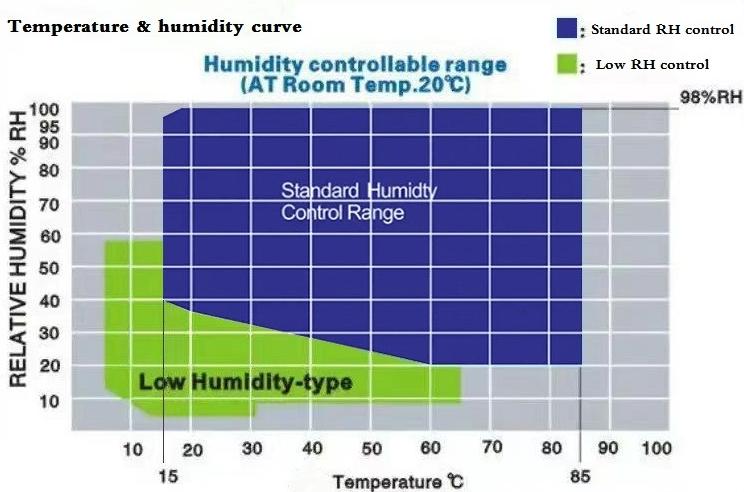
What is the structure of the humidity test chamber for climatic testing
The structure of a humidity chamber depends on the manufacturer and model, but typically consists of the following main components:
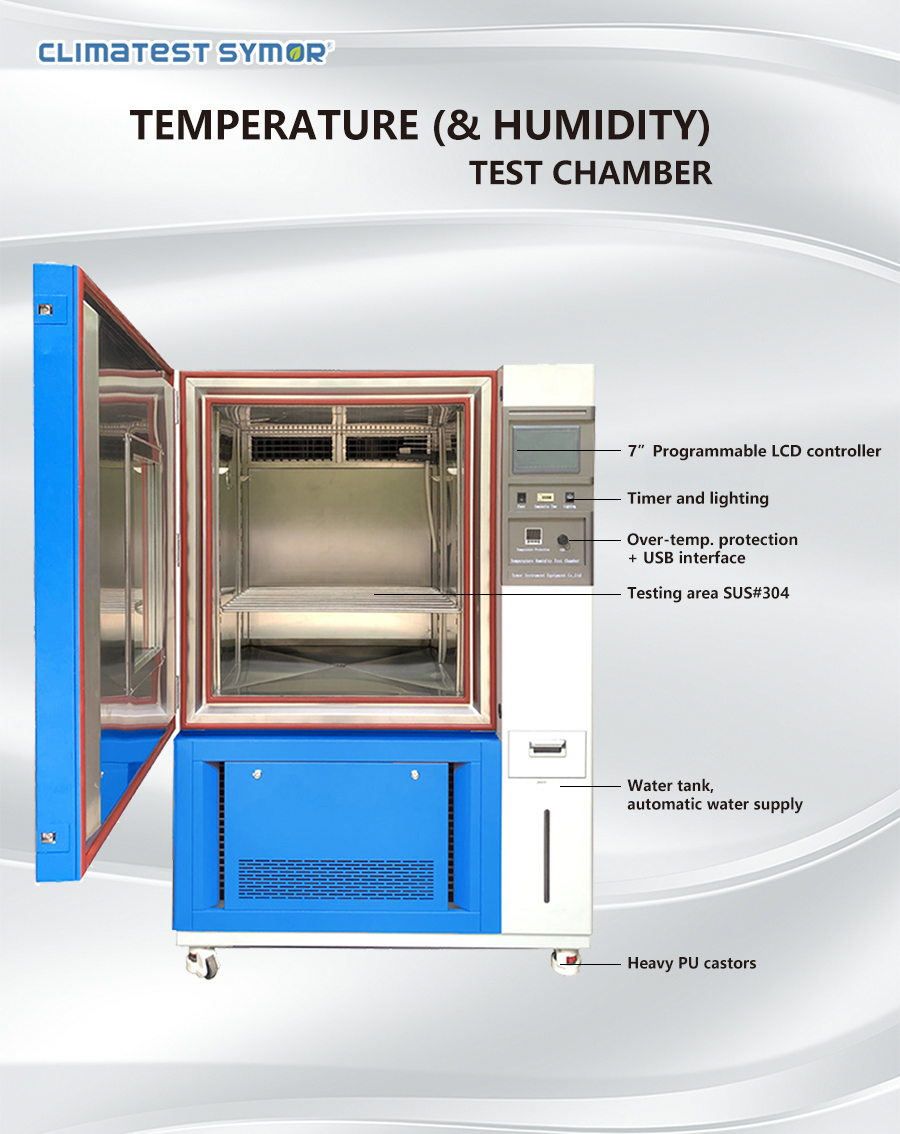
1. Working Chamber: This part is used to create a controlled environment for testing. The chamber is typically made of stainless steel SUS#304 that are durable enough to withstand the extreme temperature and humidity conditions inside.
2. Insulation: To maintain temperature and humidity levels, the chamber is typically insulated with materials such as fiberglass or polyurethane.
3. Heating and cooling system: This system adopts forced air convection to perform heating and cooling tests. To realize temperature humidity control, the test chamber should be able to carry out two functions: heating and cooling, uniform temperature also must be evenly distributed inside the working chamber, Climatest Symor® makes it possible to achieve a high degree of temperature uniformity in the whole testing area.
Humidity chamber adopts mechanical cooling system and mechanical heating system to conduct testings on products:
Mechanical heating system consists of electric heating elements positioned near the ventilation system, so that the heated hot air is delivered into the testing zone from air inlet, then come out from air outlet, meanwhile, there are centrifugal fans located at the back of the air inlet, so as to blast the hot air to reach better uniformity.
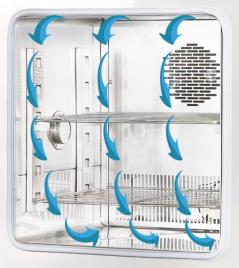
Mechanical cooling system consists of a closed circuit system, with the following main components:
·Control valve
·Condensor
·Evaporator
·Compressor

The refrigeration system in a thermal test chamber is classified to be single stage and double stage, the single stage is adopted with temperature -40℃ and above, and double stage (also called cascade system) is with temperature below 40℃.
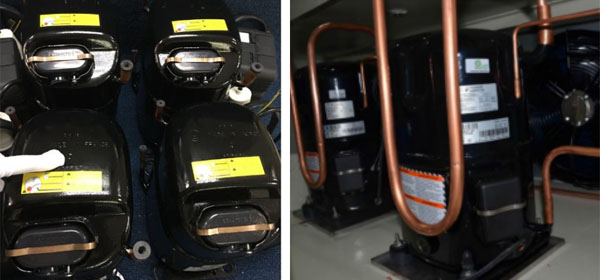
4.Humidity control system: The humidity control system is used to control the humidity inside the chamber. This system can include humidifying and dehumidifying systems.
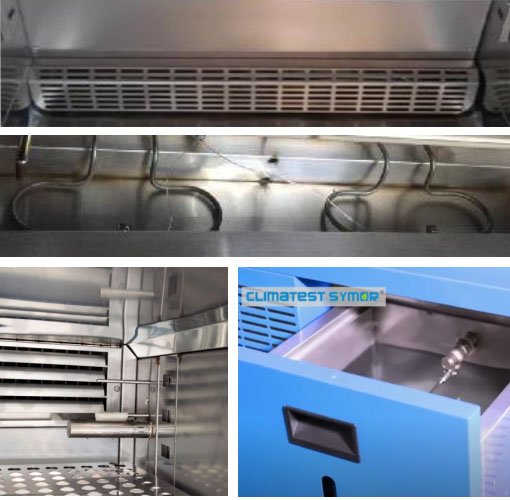
5. Control panel: The control panel is used to operate the test chamber. It typically includes a display for temperature and humidity readings, as well as buttons or knobs for adjusting the temperature and humidity levels.
Programmable LCD touch screen controller:
·7 inch Japan programmable touch screen controller
·Set temperature point under fix value mode or programs mode
·Temperature set point and realtime temperature curve display ·100 groups program with 999 segment memory; each segment 99Hour59Min
·Test data can be downloaded as required through RS232 interface

6. Sample holders: Sample holders are used to securely hold the products or materials being tested inside the chamber. These can be shelves, trays, or other types of holders, depending on the size and type of the products being tested.
7. Door: The door of the test chamber is used to access the interior. The door should be sturdy, airtight, and able to withstand the temperature and humidity conditions inside the chamber.
These are the main components of a constant temperature and humidity test chamber. The exact design and structure of the chamber can vary depending on the manufacturer and model, but these components are typically present in most models.
How to place a sample in a humidity test chamber for climatic testing?
Placing a sample in a humidity chamber for climatic testing typically involves the following steps:
1.Preparation: Ensure that the sample is clean and free of any contaminants.
Loading the chamber: Open the door and place the sample inside. The sample must keep a certain distance from the inner wall of the test chamber to ensure air circulation around the sample. Once the air flow in the chamber is blocked, the uniformity of temperature and humidity in the test chamber is reduced, and the test error will increase.

In the case of air flow, the height of the sample shelf can be adjusted according to the size of the sample being tested.
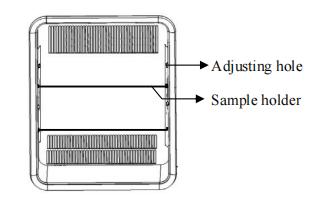
3.Setting the conditions: Set the desired temperature and humidity value on the controller.
4.Monitoring the conditions: The conditions should be regularly checked to ensure that they are within the specified range.
5.Running the test: The test can begin. The sample should be left inside the chamber for the specified duration of the test.
6.Data collection: The chamber should be equipped with a data logging system to record the temperature and humidity conditions during the test. This data can be used to analyze the performance of the sample and the results of the test.
7.Removing the sample: After the test is complete, the sample should be removed from the chamber at ambient temperature, and carefully examined for any changes or damage that may have occurred during the test.
It's important to follow proper procedures and guidelines when using a humidity test chamber for climatic testing, to ensure that the results of the test are accurate.
What is the application of a humidity test chamber for climatic testing?
Humidity chambers are used in a variety of industries and applications, including quality control testing, material and product testing, life sciences research, and environmental testing. The chambers can be used to test the effects of extreme temperatures and humidity levels on various materials, products, including:
1.Electronics: Humidity chambers are used to test the reliability of electronic components, such as semiconductors, circuit boards, and displays, under various temperature and humidity conditions.
2.Automotive: Humidity chambers are used to test the durability and reliability of automotive components, such as engines, transmissions, and braking systems, under various temperature and humidity conditions.
3.Aerospace: Humidity chambers are used to test the performance and reliability of aerospace components, such as engines, avionics, and landing gear, under extreme temperature and humidity conditions.
4.Medical Devices: Humidity chambers are used to test the performance and reliability of medical devices, such as implantable devices, diagnostic equipment, and disposable products, under harsh temperature and humidity conditions.
5.Materials Science: Humidity chambers are used to test the performance and reliability of materials, such as plastics, metals, and composites, under different temperature and humidity conditions.
In these industries, the use of humidity chambers help to ensure that products will perform reliably and consistently under different environmental conditions, and helps identify any potential problems before the product is released to the market.
In addition to product testing, humidity chambers are also used for environmental stress screening, accelerated aging, and failure analysis. These chambers play an important role in ensuring product quality and reliability in many industries, and are an essential tool for product development and testing.
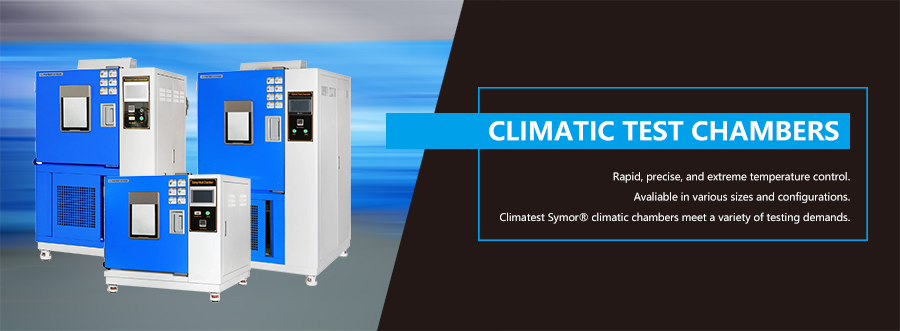
How to pack and ship a humidity test chamber for climatic testing?
The packaging and shipment of a humidity test chamber can impact its safety and performance. Proper packaging and shipment are important to prevent damage during transportation and ensure that the chamber arrives at its destination in good condition. Here are Climatest Symor® general guidelines for packaging and shipping a constant temperature and humidity test chamber:
1.Packaging materials: Use high-quality, shock-absorbing materials, such as foam or bubble wrap, to protect the chamber during transportation. You may also want to use a sturdy shipping crate to further protect the chamber.
2.Handling: The chamber is handled with care to prevent damage. It's important to use the right equipment, such as a forklift or pallet jack, to lift and move the chamber.
3.Labeling: Clearly label the chamber with "Fragile" and "This Side Up" stickers to ensure that it is handled with care during transportation.
4.Shipping method: The chamber is shipped by sea, Climatest Symor® team makes vessel booking in advance according to the size, weight, and destination of the chamber, the local transport is normally a truck.
It's important to work with a reliable and experienced shipping company to ensure that the humidity test chamber is packaged and shipped properly. Proper packaging and shipment can help ensure that the chamber arrives at its destination in good condition and is ready for use.

How to install a humidity test chamber for climatic testing?
Installing a humidity chamber for controlling temperature and humidity requires a few steps to ensure proper operation and safety.
Here is a general outline of the process:
•Choose a location: Select a room that can accommodate the size of the climate chamber and that has access to electrical power and ventilation.
•Prepare the floor: Make sure the floor can support the weight of the climate chamber and is level to prevent tipping.
• Assemble the chamber: Follow the manufacturer's instructions to assemble the climate chamber, including connecting any electrical components.
• Install the power supply: Connect the climate chamber to a power source that can handle the electrical requirements of the chamber. Make sure to use a properly rated circuit breaker and power cord.
•Connect the ventilation: Make sure the climate chamber has proper ventilation to remove excess heat and moisture.
•Install temperature and humidity controls: Connect the temperature and humidity controls to the climate chamber and calibrate them according to the manufacturer's instructions.
•Test the system: Turn on the climate chamber and check that it is functioning properly. Monitor the temperature and humidity levels and make any necessary adjustments.
It is important to follow the manufacturer's instructions and all applicable safety guidelines when installing a climatic humidity chamber.
A: ≥60cm B: ≥60cm C: ≥120cm
Attention: inclination should not exceed 15°C
